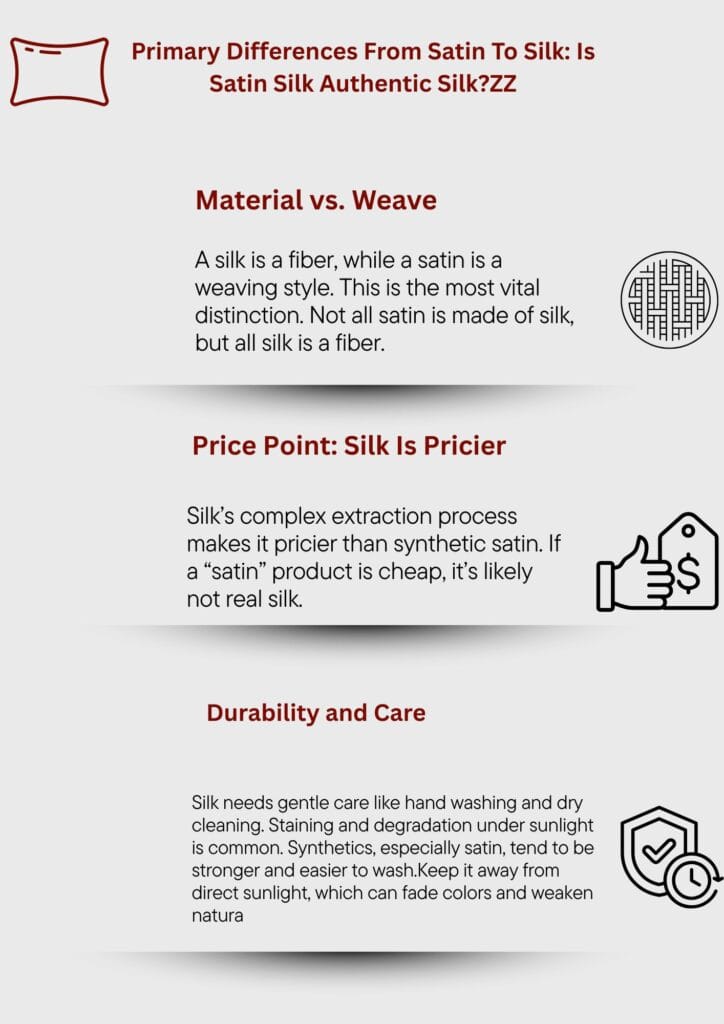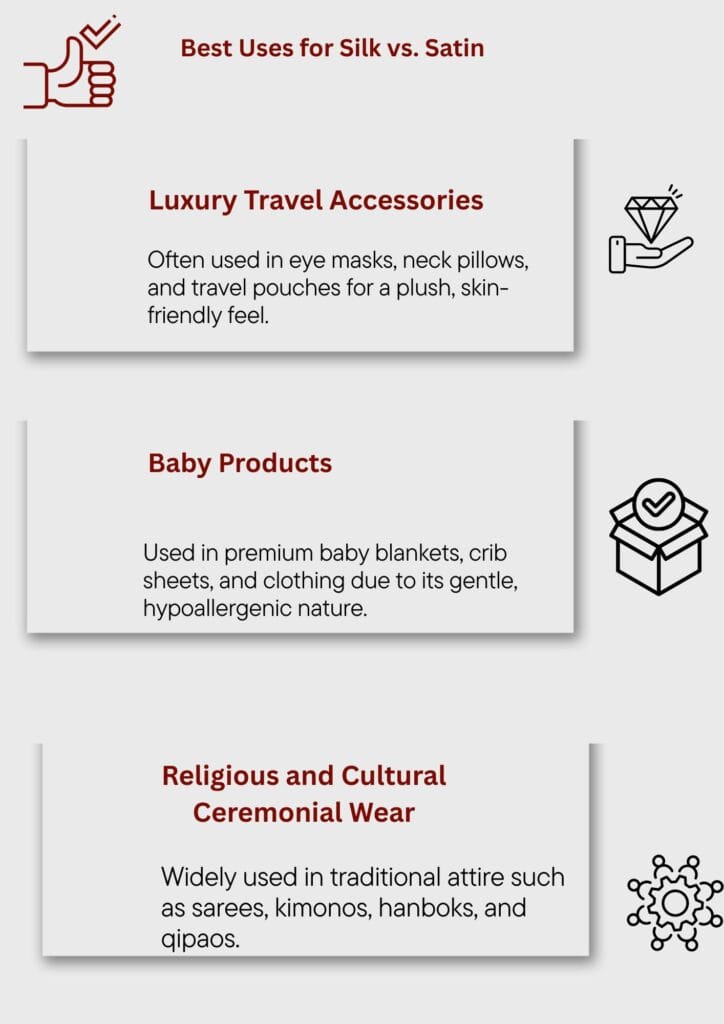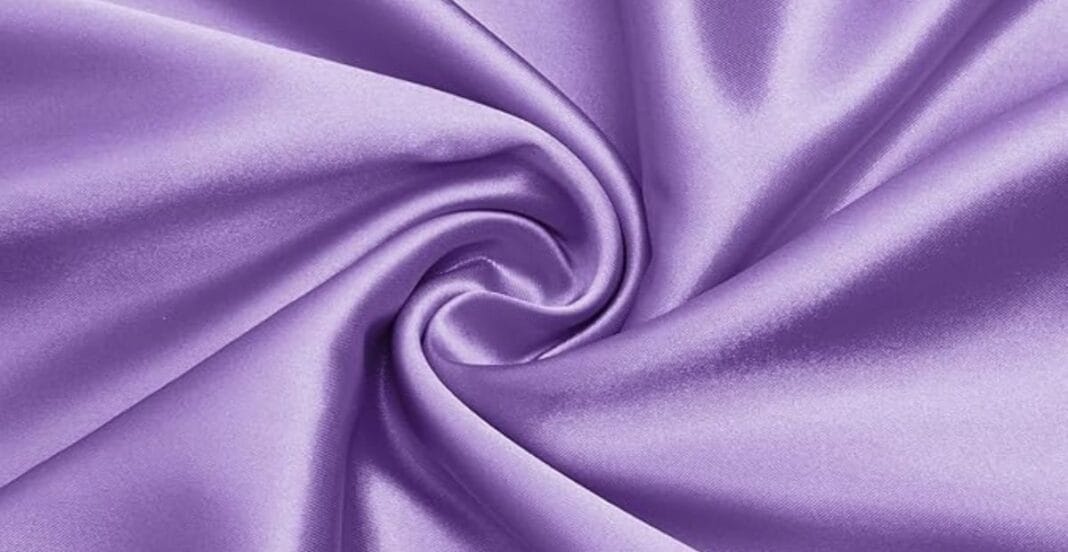Introduction
Satin and silk evoke thoughts of luxury, and smooth textures, especially. Both fabrics rule high fashion bedding and clothing. is satin silk real silk
The soft touch and glossy shine of both satin and silk fabrics leads many to think they are the same. However, the differences in their origin and composition tell a different story. Silk is a natural fiber rounded off by satin which refers to a weaving technique.
In this article, we will take a deep dive into the swimsuit silk and satin controversy. Discuss their making, their differences, how to tell base silk is real silk and more. Together, let’s bust myths surrounding.
What is Satin? The Cultured Glossy Fabric With Many Forms and Faces
Satin is Not a Fiber
Every fabric has its trademark features, satin’s trademark is the soft glossy shine. This does not mean satin is a kind of fiber. It refers to a specific weaving technique. Features like a certain pattern to place most threads on the surface and a smooth and glossy face gives satin its signature look.
Unlike silk, satin can be made from different materials. The weave can use fibers like polyester, nylon, or even silk. Therefore, saying “satin” does not tell you the actual fiber content of the fabric — this only uses how the fabric was woven.
Fibers Used in Satin Fabrics
Satin can be made from various fibers. The most common include:
- Polyester: The most affordable and durable option.
- Nylon: Lightweight and soft.
- Acetate: Often used in linings.
- Silk: The most luxurious and expensive.
Synthetic satin is popular for its affordability and resilience. However, when satin is woven from silk, it becomes silk satin—premium, natural luxury fabric.
Satin’s Key Characteristics
Satin is loved for having a shiny surface that is smooth to the touch and catches light: a feature which also makes satin very popular.
Suspended poly fabric may be dazzling, but it does not offer the breathability and hypoallergenic qualities silk brings. Furthermore, its shine comes mainly from the weaving rather than the material
What is real silk? Nature’s Luxury Fiber
Definition And Origin Of Silkworms
Silk is a natural protein fiber obtained from the cocoons of the silkworm, especially the Bombyx mori. This fiber has been prized for thousands of years for its luster, softness, and exclusivity.
Like most fabrics, silk is considered biowaste and decomposes naturally. It is one of the oldest materials used in clothing and a symbol of status. Silk is often considered the gold standard of fabrics for its unmatched quality and feel.
Benefits of Silk
These benefits of silk are hard to come by in synthetic fabrics:
- It is breathable and adjustable to body temperature.
- Hypoallergenic and friendly to skin.
- Silk is soft with a luxurious sheen.
- Lightweight yet strong.
Silk’s benefits greatly aid those with sensitive skin and those who desire comfort.
Types of Silk
Different types of silk are:
- Mulberry Silk: Produced from the Bombyx mori silkworms , this is the highest quality silk.
- Wild Tussah or Tussah (Wild Silk): A more textured, coarser silk.
- Eri silk: This silk is also tough, and has a wooly texture.
- Muga: Known for its golden hue, Muga silk is rare.
Knowing these differences helps in answering the important question: Only if the satin is woven from authentic silk fibers can it be considered real.
Primary Differences From Satin To Silk: Is Satin Silk Authentic Silk?

Material vs. Weave
A silk is a fiber, while a satin is a weaving style. This is the most vital distinction. Not all satin is made of silk.
Different satin types include silk satin, but there’s also polyester satin or nylon. Knowing the fiber source is key to identifying real silk.
Price Point: Silk Is Pricier
Silk’s complex extraction process makes it pricier than synthetic satin. If a product is cheap, it’s likely not real silk.
Always check tags so you don’t get confused. Authentic silk products usually state “100% Mulberry Silk” on the label.
Durability and Care
Silk needs gentle care like hand washing and dry cleaning. Staining and degradation under sunlight is common. Synthetics, especially satin, tend to be stronger and easier to wash.
For those who value comfort over extravagance, satin might be the more convenient option.
Breathability and Skin Feel
Fabric is much more breathable than synthetic. It keeps the temperature even, reduces sweating, and works well as sleepwear or bedding.
Satin may be a bit less breathable and airy if it is made out of polyester, which comes off as cheap or synthetic.
Appearance and Shine
Both fabrics are shiny, but the shine differs. Silk has a natural soft shine while satin has high-gloss, mirror-like finish due to its weave.
Satin looks flashier, and silk looks more refined and subtle.
Is satin made from real silk?
Difference Between Silk Satin
Yup! Silk is a made with silk ribbons and thus is the best of both worlds. It has a shiny texture with soft silk fibers.
But most affordable satin is made with cheaper satin fabrics such as polyester. Though these versions are cheap, they do try to mimic and shine like silk.
How to Determine if It’s Real Silk Satin
Look for this label:
- 100% Mulberry Silk
- Charmeuse (a type of silk satin)
Real silk is pricier and is rare to find in anything but designer or luxury brands.
“Silk-” Marketing Tactics
Many retailers use these words very broadly, like “satin”. In some cases, these products don’t have real silk in them, as their names suggest. Make sure to double-check product descriptions.
Marketing can be tricky; your best bet is to be armed with information.
How to Identify Real Silk vs Satin
Burn Test
Burning a small thread is a common method used to test silk. Boa or silk will smell and leave an odor of burnt hair, a soft ash, a good piece to burn would be a polyester satin, which melts, leaving a fragrant of plastic odor. People are careless, but safety is a must.
Always exercise this option in a place where flames are a risk.
Touch and Drape
A buttery-soft texture is something silk carries. Although satin too is a softer material, it usually has a slippier feel. A good experiment to find this out would be to try draping. Unlike cotton, real silk will flow, while most synthetics will cling or bunch.
Label Inspection
Look out for tails that mention,
- ‘Charmeuse Silk”
- 100% Mulberry Silk
If the tag does not say “satin.” It says “polyester”; then it is not silk.
Price Clu
A cheap price equals a synthetic product. Authentic silk will have a high price, which is a clear gold stamp of trust.
Common Misconceptions About Satin and Silk
Myth 1: All Satin is Silk
This is wrong as most satin products are synthetic and not.
Myth 2: Silk and Satin Feel the Same
When these two materials are compared, silk is warmer, softer, and much more breathable.
Myth 3: Satin Is Always Cheaper
It’s true that synthetic satin is less expensive. However, silk can be pricier than plain woven silk. Thus, costs differ due to both the weave and the fibre used.
Best Uses for Silk vs. Satin

Silk Uses
Silk is great for:
- Luxury parts covers
- Upper-scaled garments
- Scarves and jewellery
Works well for hot temperatures and sensitive skin because its breathable and elegant.
Satin (Synthetic) Uses
Satin is often put to use in :
- Fashion at lower prices
- Dress linings
- Bridal and prom dresses
formal dresses because of its shine and low price.
Silk Satin Uses
For designer gowns, gilt edged underwear and haute couture, silk satin is the best choice.
It has the best of both silk, having the shine of the former and the smoothness of the latter makes it indeed very sophisticated.
Benefits and Drawbacks of Silk and Satin
Silk: Benefits and Drawbacks
Pros:
- Eco-friendly and fully natural
- Allergic reaction (if any) is minimal
- Allows airflow and controls temperature
Cons:
- Costs a lot
- Needs special cleaning
- Easily wrinkles and gets stained
- Satin: Benefits and Drawbacks
Pros:
- More economical and easy to find
- Stronger and can be washed in machine
- Very shiny appearance
Cons:
- Not as much air circulation
- May have a plastic feel
- A lot of the time does not prevent allergies
Conclusion
In short terms–satin is not always real. Satin is a weave and silk is a fiber. Some fabric is made from real, but the majority of today’s satin is made from artificial materials.
When buying something, feel the fabric, check for its label, and think about the price. Understanding the difference guides you to make the right choice in fabric that suits your budget, lifestyle, and requirement. So, whether you are buying a gown, bedding or even a scarf, ensure that you are paying the right price for the right product.
FAQs
The most significant difference is thats a natural fiber, while is a weaving technique. Silk can be turned into, and satin can be made of non-silk fibers like polyester or nylon.
Polyester satin is less breathable, may feel synthetic, and doesn’t offer the same comfort or luxury. On the other hand, is softer, more breathable, hypoallergenic, and temperature-regulating.
The fact that both fabrics look shiny and smooth is the reason for confusion. While the glow in silk is natural, soft, and gentle, the shine in due to the weave. Marketing terms such as serve to only further the confusion.
Light and glossy satin weaves are referred to as charmeuse. It can be made from real silk or synthetic fibers. If it says “Silk Charmeuse,” it’s genuine silk, but always check the label if you want to make sure.


